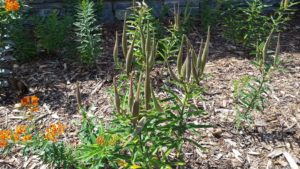Milkweed (Asclepias tuberosa), aka butterfly weed, is a long-lived tuberous rooted perennial indigenous to the southeastern U.S and mid-western U.S. and Canada (USDA hardiness zones 3 to 9). It grows in dry/rocky open woodlands, prairies, farm fields, and along roadsides. Individual plants typically grow as a clump to 2- 3 feet high and 1 -2 feet wide. Unlike many of the other milkweeds the sap is not milky.
For almost six weeks, from late spring into summer, clusters of vibrant orange to yellow-orange flowers (umbels) cover the plant canopy. The narrow, lance-shaped leaves are attached to hairy stems. Flowers are an important nectar source for many butterfly species and leaves are an important larvae food for monarch butterflies.
Butterfly weed freely self-seeds in the landscape. Prominent 3 – 6 inch long spindle-shaped seed pods break open when ripe and release multitudes of silky-tailed seeds which may carry a long way by wind. Seed pods may be utilized in dried flower arrangements.
Butterfly weed is a perfect choice meadow or prairie garden for full sun. It grows in average, dry to medium, well-drained soils in full sun. It does well in poor, dry soils, and established plants are highly drought tolerant. Shoots emerge late in the spring and grow rapidly. It frequently included in butterfly gardens, meadows, prairies, or other plantings.
Plants are easily started from seed, but may take 2 – 3 years before flowering. Do not try to dig up wild plants as they rarely survive transplanting because of their deep taproot system. Young seedlings are best left undisturbed for two years to become established.
Few disease and insect problems trouble butterfly weed if grown in the proper site. Wet poorly-drained soil usually results in rot rot diseases. Leaves are susceptible to rust and leaf spots, often in overcrowded plantings. In medical circles the plant is commonly called “pleurisy root”, and once used to treat wheezing and coughing.
Their bright orange flower clusters are among our showiest native wildflowers and picked for floral arrangements.
‘Hello Yellow’ is a yellow flowering cultivar.


 Posted in
Posted in 
